Ant: Funny you should say that—I actually just purchased my first piece of original Magic art! Well . . . sort of. It’s a canvas print of a digital piece.
Mike: I actually picked up a piece I’ve been looking for that’s part of my malicious Commander deck. This calls for an article. Maybe you talk about what it means to have a “digital original,” and I talk about a traditional painting. Old school will meet new school, and we can cover both. How does that sound?
Ant: Sounds like two dudes are about to get their Vorthos on.

A Private View at the Royal Academy (1883) by William Powell Frith
Background
Mike: So, I’ve written about buying art in the past here, here and here. (There’s more, but those will do.) But I have to sadly say that those are all out of date and no longer reflect reality. Some pretty seismic shifts have occurred in Magic original-art-buying, and much of it is due to the aging player base of Magic. If you can’t play Friday Night Magic each week anymore because you still had all these kids, your interaction with the game is infrequent at best.
Enter art.
By buying an original painting, you are able to interact with Magic every single day on your wall, in your morning routine, as you search for your good belt or find a tank top that doesn’t clash with your sweater. Add to the fact that the recession is far enough back in people’s minds, and we have a petri dish for Magic art to gain prominence with our player base.
Ant: I can definitely relate to that logic. The piece I recently purchased is hanging on the wall in my home office, and seeing it every morning reminds me of sifting through mountains of Magic cards as a kid. While I no longer have the time to sit up until 3:00 A.M. organizing my collection of red burn spells, being able to look at the stunning art for one each morning feels just as good. It’s a nice kick of nostalgia to go along with my morning coffee.
Mike: I walk into my office and I enter a Multiverse of sorts, seeing all the planes of possibility on my wall. It’s a mini-museum, and I welcome Ant into the club/disease that is owning art of your favorite game. I wish it were an easier task to acquire art. But alas, the difficulty acquiring art you want is quite high.
 | 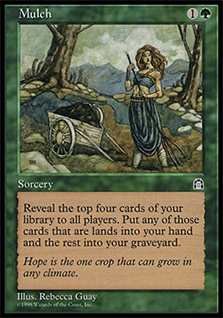 |
Mike: How it should work to acquire art is you look up an artist via Google—or a handy list I made not so long ago cleverly called Contacting a Magic Artist—and you e-mail the artist inquiring about an original art. He or she has it in stock for some price, you pay it, and after anxious waiting by your window, you receive a package.
That isn’t how it works anymore, and it surely isn’t as easy as attending a convention, a Grand Prix, or a bazaar of artworks. Tell me, Ant, how did it shake out for you?
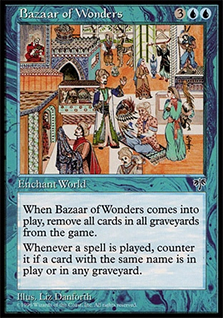
Acquiring a “Digital Original”
Ant: So, before I talk about how I picked up my piece, I think it's important to talk about why I did it.
Lightning Javelin is a card I wrote the name for in Magic Origins, and was my first publicly revealed card. Seeing Lightning Javelin on the mothership in a preview article made it official: I had finally contributed to my favorite game in a creative way.
The first real deck I ever made was a red burn deck filled with Flame Rifts and Lightning Bolts. If someone were to tell little Ant that he would one day grow up to name a red burn spell that would fit seamlessly into his favorite deck, let me just say that little Ant would have died of laughter. To say that the card Lightning Javelin holds an importance for me would be an understatement.
Lightning Javelin also happens to be illustrated by one of my favorite Magic artists: Seb McKinnon.
Mike: My favorite sandwich is the Jucy Lucy, a cheese injected hamburger, but that American Dream in a burger needs no explanation why it’s delicious. Art, though, is subjective. What’s up with Seb to drive your interest?
Ant: Seb has this abstract quality in his work that I find really lends itself to a fantasy property. His images remind me of old Magic works found in Mirage like Bone Mask or Delirium while still meeting the newer standards set for today’s Magic.
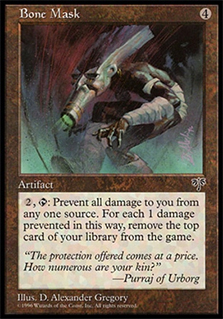 | 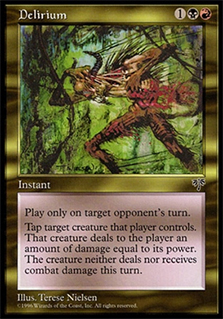 |
Over the year or more that I have been writing for Gathering Magic, I have developed a friendship with Seb, featuring his incredible art in many of my articles. I reached out to Seb with the idea that it would be cool to buy a print of the card on stretched canvas and maybe pick up an artist proof to go with it. What I didn’t expect was what came next.
Lightning Javelin is a digital work. In theory, Seb could print off a million prints to sell as long as there was a market for them. Seb must have been moved by my desire to have his art hanging on my wall in celebration of my accomplishment as a writer—he amazingly offered to never print the image again in any form, basically causing my canvas print to become an “original” artwork for his digital piece.

Mike: Ah, the unique original. Yeah, this has been done for a few years now. John Stanko is really clutch at it. His Innistrad human figures were printed on canvas and then touched up with paint. You see, digital prints on canvas often wash out the darkest darks, so you need to touch them up. That unique “digital but a little something” makes for a unique painting. Did Seb do any such touchups for your image, Ant?
Ant: I had originally asked that he do so, but upon receiving the print, Seb felt the image came out so clearly that adding additional darks or lights wasn’t necessary.
Mike: When an artist agrees to never make a secondary copy, you then have an artist’s intention for that print to be a unique piece. These are incredibly rare, and I wish more players knew this can be done. Good for you, Ant. You glimpsed behind the curtain.
While purchasing canvas prints is a great way to enter into the art-buying game, your situation doesn’t help the everyman interested in acrylic, oil, watercolor, and the actual smell of varnished paint.
Ant: Enlighten us, oh wise one! What’s a Magic player have to do to get some paint on his or her walls?
Mike: How it more often works is you ask the artist and he or she is sold out of your favorite work (e.g. Llanowar Elves. It’s a shocker to me, too, that a card from 1993 hasn’t had anyone interested enough to buy it yet).
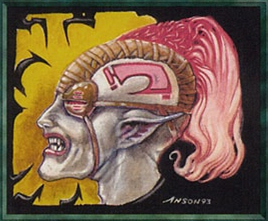
The worst-case scenario is when an artist says, “Homie, I work in Adobe Photoshop; there is no original.” And then you scrambled to find what to say next. In this case, people can default to your example, Ant.
Painted Original and Mike
Mike: But when you’re looking for a real O.G., a real painted, needs-to-be-preserved piece, it has changed so much.
I don’t collect many of Magic original paintings, despite buying a ton. I often have folks lined up already. You see, I keep a running list of “grails,” or pieces folks are interested in. When I come across a piece, I pick it up for those people. Because the chance is that if they’re no longer interested, there’s bound to be someone else who is. It just works out like that.
On the off chance I do think of something I need that isn’t a land panorama, I exchange a ton of e-mails with the artist. In this instance, I looked at my wall and exclaimed, “I don’t have anything from Ron Spears. I should look into my decks.”

Ron Spears, Award-Winning Artist, Teacher, Good PeopleImage cropped from his Facebook page
Mike: Lo and behold, Phyrexian Altar is in my utterly gross Melira, Sylvok Outcast combo deck. I know it’s a vibrant piece, but I couldn’t imagine it was still there. Ron and I exchanged a few messages, and he said he would only be back in his studio for a few weeks. He’s an art-school teacher, of course, and he practices out of his state.
Ant: That deck is bad, and you should feel bad.
Mike: Hater’s gonna hate. I play to win, homie. As I was saying, Ron not only had Phyrexian Altar, but he also still had Hypergenesis. Faster than Milk Dud snuggles his giraffe after a long day, I talked to my wife about having my birthday gift be an additional piece of art.

Mike: In this instance, I was lucky after only two months between first contact and actual purchase. It can take months to years to not only find older work, but also to pay via a payment plan.
Once you finally acquire your piece, you reach the hard part: framing. Trying to figure out how to perfectly frame these colorful pieces—and also how to frame the throw-in sketch Ron sent me (Condescend)—will be a fun puzzle, not to mention that I can’t open it until my thirtieth birthday.
Ant: Only you would contact an artist about buying one iconic original work and come out with two and a sketch.
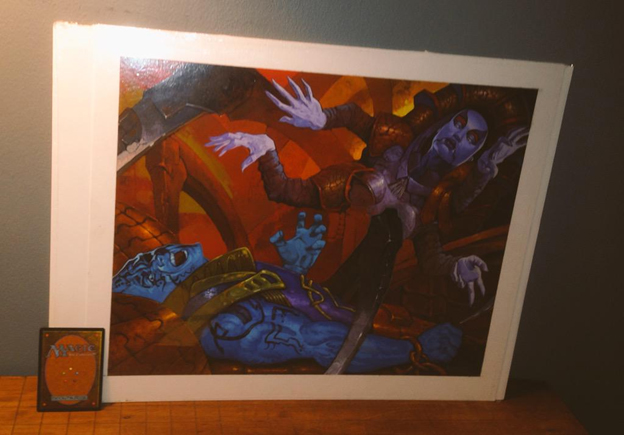

Mike: Honestly, we both made out well. Why do you think that is? Do you have any tips for the Artist Vorthoses out there looking to up their art game?
Ant’s Art Buying Pro Tips
If you are looking to pick up a print of an artist’s digital work, ask him or her what options you have available. Here are some general questions I would ask the artist prior to making your purchase:
What are the images printed on?
This question seems silly at first, but knowing what your options are can help lead you in the right direction. Seb offered two different print options of giclee on watercolor paper and giclee on stretched canvas.
What sizes are available?
Again, this is super-important for understanding what you are purchasing. Nobody wants to accidentally buy something too big (or too small).
For giclee prints, do you offer an option to have it touched up with paint?
As Mike mentioned above, prints can often cause lights and darks to not show up as clearly as they would in paint. Some artists will touch up these areas with actual paint, which is cool, as it adds some extra flair and originality to your purchase. Keep in mind that touchups will cost extra, as you need to pay the artist for the time he or she spends on your piece!
How do you authenticate your prints? Do you sign or number them?
Any time you are purchasing a limited run of any item, you should try to have some form of authentication to go along with it (thanks, Pawn Stars!). Telling me your print is #3 of 50 means nothing if it doesn't have “3 of 50” somewhere to prove it. In my case, Seb sent along a signed letter of authentication to go along with the print.
How do you ship the print?
Here’s another vitally important question. If possible, always ask to have your prints shipped flat. If the artist says it will cost extra, pay that extra. It is worth the money. Creases and rolled paper can ruin an otherwise amazing print.
Are there preliminary sketches of the piece available?
This is something I wish I would have asked Seb, but I didn’t. Many artists who work digitally start off with real sketches that they scan into the computer. Sketches are an easy way for you to have a unique original, and they add extra flair when framed next to the finished piece.
Do you have any artist proofs available?
Artists receive blank-back proofs of their cards. If you are picking up a print, pick up an artist proof to go along with it! They really are not that much ($5–$15, usually depending on the card), and they often come signed or with a cool sketch on the back. Here is the proof I picked up from Seb:
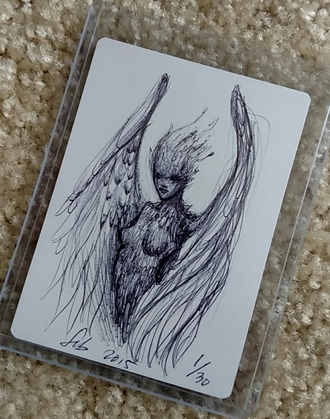
What about you, Mike? What are some new things to consider if someone out there wants to purchase some original Magic art?
Mike’s Art Buying Pro Tips
I've been doing this a while. Here are some tips and tricks to help you dive head first into the world of original art.
If buying an original, asking for an artist proof is totally normal thing to ask for.
Obviously, there hits a threshold when “throwing one in” is kosher. Is it a combat-trick card? Sure. Is it a foil Planeswalker? You might need to pay quite a bit extra.
Not all art is $1,000 or more.
Every card art that is in an established Vintage, Legacy, or Modern deck is absolutely all $1,000, though, if that makes sense. Many pieces can be still had for $400–$500.
Payment plans are your friends.
Down payments are always a must. I’ve only had one artist refuse them, and only because he wanted a shorter term due to his taxes being done, which was fair. When you’re dealing in boom-boom artworks, such as those worth $3,000 or more, payment plans are very common with artists. (They’re less common between collectors.)
Don’t assume sketches are included.
I learned this the hard way with Donato Giancola’s Archivist. I found that out later. Often, for $20–$150, you can have those, too, and those often have final tight sketches, preliminary loose ones, thumbnails, and more. Talk about a few mini-frames of cool!
If the piece you’re looking for was already sold, patience is your friend.
Art collectors aren’t evil, but rude or impolite people are quickly dismissed. It’s a small community with a long memory. It works in your favor if the piece you’re looking for isn’t known. Heck, it may end up finding you!
That’s a Wrap
Mike: Snack Time!
Ant: You just can’t resist doing that can y—
Mike: Snack Time!
Ant: Ah! Why did I agree to do this with you?
Mike: Because Milk Dud is a must-pet?
Ant: Can’t argue with that logic! Thank you, everyone, for joining Mike and me on this extra-special art-buying adventure. Let us leave you with a final piece of advice . . .
Mike and Ant: The holidays are fast-approaching. Get out there, and pick up some art for your special someone!



























